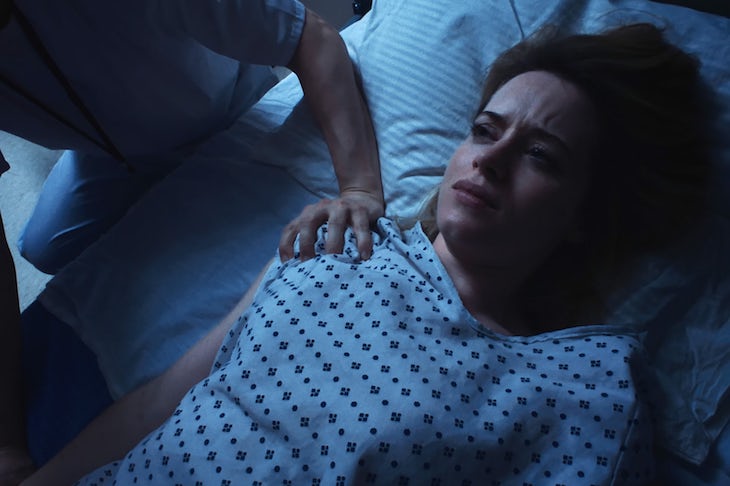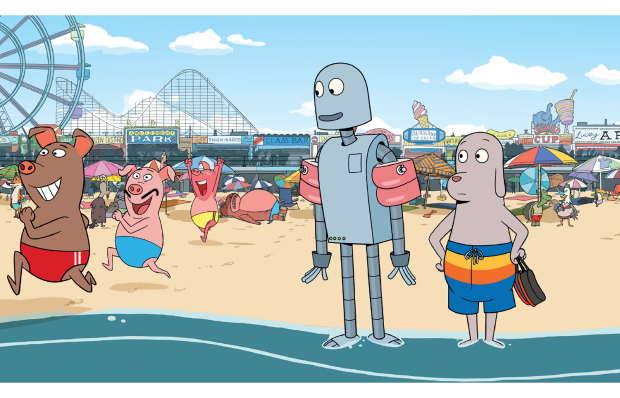Steven Soderbergh’s latest film, Unsane, is a psychological thriller about a woman who is incarcerated in a psychiatric hospital even though she claims to be perfectly sane. But is she? It was filmed fast, on an iPhone 7, and some aspects are worryingly thoughtless — its treatment of mental-health patients, for example, is remarkably Unsensitive. And it does descend into a plainly ridiculous, sub-par farce. But it is also, in parts, deliciously schlocky and it stars the wonderful Claire Foy, whom one hopes was paid decently. So shocking that she earned less than Matt Smith for The Crown, but as a positive person who likes to look on the bright side might I suggest that we celebrate the fact men are still doing so well? And throw a party or something?
Here, Foy plays the unlikely named Sawyer Valentini, who has relocated from Boston to Pennsylvania to escape David Strine (Joshua Leonard), the man who has been stalking her for two years and has made her life hell. She has a new job in a bank where the boss instantly comes on to her — Soderbergh is clearly down with the women, sometimes clumsily so — and she’s in a state. She’s lonely, but suffers panic attacks, which makes dating impossible. So she seeks therapy, and undergoes a session with a seemingly sympathetic counsellor at the Highland Creek Behavioural Centre. She confesses that, yes, she’s had suicidal thoughts, but hasn’t everyone at some time or another?
She signs some papers, which she thinks are simply committing her to further therapy sessions, but then discovers she’s admitted herself as an inpatient. She is put on a locked mixed ward where the woman (Juno Temple) in the next bed threatens her with a dangerously sharpened spoon. Meanwhile, the staff are profoundly Unhumane, and just dish out drugs, Nurse Ratched-style. One appreciates that, for plot purposes, this has to be a scary, perilous, unreasonable place but, still, it seems a pity that its view of mental illness and treatment is very definitely stuck somewhere in the dark ages, possibly around 656AD.
This is, essentially, the classic mental hospital set-up, based on the well-worn trope of a woman (usually) who keeps protesting that she doesn’t belong here, it’s all a horrible mistake although, of course, the more she protests the madder she is taken to be. (See Olivia de Havilland in The Snake Pit and Elizabeth Taylor in Suddenly, Last Summer, and so on.) But it takes a fresher turn when Sawyer claims that one of the orderlies, who is calling himself ‘George Shaw’, is, in fact, David Strine. But is he? Has she been locked up with her stalker?
As I don’t wish to stray into spoiler territory, I’ll speak just in generalities from now on. There are those deliciously schlocky twists, which are often ingenious, and although shot on an iPhone, it’s an iPhone with a hefty amount of extra kit, so there’s none of that dimly illuminated, shaky handheld nonsense. And Foy is magnificent, worth twice the money, whatever the original sum was. (But don’t worry, fellas. This won’t affect our party. At all.) True, Sawyer is a victim but it’s not as straightforward as that, as she is awarded agency, and we see how stalking can not only turn you into a wreck, but also becomes the crime that you are meant to prevent. (This is shown via flashback, and a police security expert — a cameo from Matt Damon — telling her the precautions she must take: quit Facebook, don’t park out back, always carry your keys in your hand.) It is also, I have to say, quite a neat metaphor for the whole #MeToo business, as it’s fundamentally about women who are not believed, and whose stories are thereby discounted.
That said, and as written by Jonathan Bernstein and James Greer, the film can feel like 98 minutes of mansplaining, and it is thematically messy, as it throws so much else into the pot, like the American private healthcare racket. Plus, it has plot holes so huge you can likely see them from Mars — ‘oh, for God’s sake,’ I said many times —and the third act is preposterous, so wholly Uncredible I started laughing. Probably the best thing here is Foy, and they should have paid her six — if not 20 — times as much. The party is still on, though. Your place or mine?
Got something to add? Join the discussion and comment below.
Get 10 issues for just $10
Subscribe to The Spectator Australia today for the next 10 magazine issues, plus full online access, for just $10.
You might disagree with half of it, but you’ll enjoy reading all of it. Try your first month for free, then just $2 a week for the remainder of your first year.














Comments
Don't miss out
Join the conversation with other Spectator Australia readers. Subscribe to leave a comment.
SUBSCRIBEAlready a subscriber? Log in